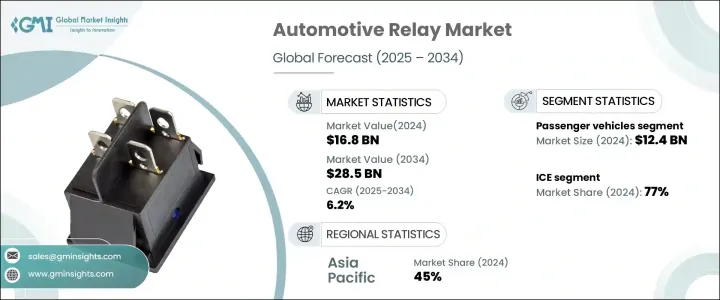
세계의 자동차용 릴레이 시장은 2024년에 168억 달러에 이르렀으며, 2025-2034년 연평균 복합 성장률(CAGR) 6.2%로 확대될 것으로 예측됩니다.
자동차 제조업체가 중요한 기능을 지원하기 위해 다수의 릴레이를 신차에 내장하고 있기 때문입니다. 승용차나 상용차의 고급 전자 시스템의 수요는 계속 증가하고 있어 효율적인 릴레이의 필요성이 높아지고 있습니다. 최근 자동차는 배전, 조명, 공조 제어, 인포테인먼트, 안전 시스템에 릴레이를 이용하고 있어 시장 확대에 박차를 가하고 있습니다. 게다가 전기 자동차의 보급이 업계 동향을 형성하고 있어 EV는 배터리 관리, 모터 제어, 배전에 고성능 릴레이를 필요로 하고 있습니다. 기존 자동차와 달리 EV는 안전하고 효율적인 운전을 위해 고전압 릴레이에 의존하고 있어 시장 성장을 더욱 자극하고 있습니다.

시장은 차량 유형별로 분류되며, 2024년에는 승용차 부문이 124억 달러를 벌어들여 우위를 차지했습니다. 이 부문은 예측 기간 CAGR 6.6%로 성장할 것으로 예상됩니다. 승용차에서 쾌적성, 안전성 및 고도의 커넥티비티 기능에 대한 수요의 고조가, 릴레이의 채용을 촉진하고 있습니다. 소비자는 파워 윈도우, 조명 시스템, 파워트레인 제어, ADAS 기능의 원활한 조작을 기대하고 있으며, 제조사는 더 많은 릴레이를 통합하도록 되어 있습니다. 개발도상 지역에서의 도시화 및 가처분소득 증가가 승용차 판매를 더욱 뒷받침하고 자동차용 릴레이의 추가적인 수요를 창출하고 있습니다.
| 시장 범위 | |
|---|---|
| 시작 연도 | 2024년 |
| 예측 연도 | 2025-2034년 |
| 시작 금액 | 168억 달러 |
| 예측 금액 | 285억 달러 |
| CAGR | 6.2% |
추진 유형별로 세분화하면 내연기관차(ICE)와 전기차가 있습니다. 2024년에는 내연기관차가 시장 점유율의 77%를 차지했습니다. 그러나 EV 부문은 2025-2034년 CAGR 7.2% 이상으로 확대될 것으로 예측됩니다. 가솔린 차량과 디젤 차량에서는 엔진 관리, HVAC 시스템, 연료 제어, 조명 기능에 릴레이가 필요합니다. 이러한 상황에도 불구하고 EV 분야는 정부의 인센티브, 엄격한 배기가스 정책 및 배터리 기술의 진보에 힘입어 큰 폭의 성장을 이루고 있습니다. 이들 자동차는 배터리 관리, 충전, 전력 제어를 위해 고전압 릴레이를 필요로 해 시장 수요를 더욱 끌어올리고 있습니다.
자동차용 릴레이는 용도별로 파워트레인 시스템, 차체 및 안락성 시스템, 안전 및 보안 시스템, 인포테인먼트 커넥티비티, 배터리 관리 및 충전 시스템으로 분류됩니다. 자동차 제조사들이 승객 편의 향상을 위해 전자부품 통합을 지속함에 따라 차체 및 안락성 시스템 분야가 선도할 것으로 예상됩니다. 릴레이는 파워 윈도우, 센트럴 록, 시트 조정, 선루프, 공조 조정의 자동 제어를 가능하게 합니다. 고급차 시장의 확대는 고급 전자기기에 대한 수요와 맞물려 이 분야에서의 릴레이 이용을 가속화시키고 있습니다. 또한 자동 와이퍼, 히터 미러, 안티 핀치 윈도우 기구 등의 안전 기능에 대한 규제 의무화도 릴레이 채택 확대에 기여하고 있습니다.
지역별로는 아시아태평양이 2024년 시장 수익 점유율의 45%를 차지했습니다. 이 지역의 좋은 자동차 생산 산업은 전기차와 하이브리드 모델의 고전압 릴레이 수요 증가와 함께 시장 성장을 뒷받침하고 있습니다. 주요 기여국인 중국은 EV 분야의 급속한 확대 및 대량 자동차 제조에 견인되어 34억 1,000만 달러의 수익을 올렸습니다.
The Global Automotive Relay Market reached USD 16.8 billion in 2024 and is projected to expand at a CAGR of 6.2% between 2025 and 2034. Rising global vehicle production is a major driver, as automakers integrate numerous relays into new vehicles to support critical functions. The demand for advanced electronic systems in passenger and commercial vehicles continues to increase, driving the need for efficient relays. Modern automobiles rely on relays for power distribution, lighting, climate control, infotainment, and safety systems, fueling the market's expansion. Additionally, the growing adoption of electric vehicles is shaping industry trends, as EVs require high-performance relays for battery management, motor control, and power distribution. Unlike traditional vehicles, EVs depend on high-voltage relays for safe and efficient operation, further stimulating market growth.

The market is categorized by vehicle type, with the passenger vehicle segment dominating in 2024, generating USD 12.4 billion. This segment is expected to grow at a CAGR of 6.6% throughout the forecast period. The increasing demand for comfort, safety, and advanced connectivity features in passenger cars is driving relay adoption. Consumers expect seamless operation of power windows, lighting systems, powertrain controls, and ADAS features, leading manufacturers to integrate more relays. Urbanization and rising disposable incomes in developing regions further support passenger vehicle sales, creating additional demand for automotive relays.
| Market Scope | |
|---|---|
| Start Year | 2024 |
| Forecast Year | 2025-2034 |
| Start Value | $16.8 Billion |
| Forecast Value | $28.5 Billion |
| CAGR | 6.2% |
Segmented by propulsion type, the market includes internal combustion engine (ICE) and electric vehicles. In 2024, ICE vehicles accounted for 77% of market share. However, the EV segment is anticipated to expand at a CAGR of over 7.2% from 2025 to 2034. Gasoline- and diesel-powered vehicles require relays for engine management, HVAC systems, fuel control, and lighting functions. Despite this, the EV sector is experiencing substantial growth fueled by government incentives, strict emissions policies, and advancements in battery technology. These vehicles require high-voltage relays for battery management, charging, and power control, further driving market demand.
Based on application, automotive relays are classified into powertrain systems, body and comfort systems, safety and security systems, infotainment and connectivity, and battery management and charging systems. The body and comfort systems segment is expected to lead as automakers continue integrating electronic components for enhanced passenger convenience. Relays enable automated control of power windows, central locking, seat adjustments, sunroofs, and climate regulation. The luxury vehicle market's expansion, coupled with demand for high-end electronics, is accelerating relay usage in this category. Additionally, regulatory mandates for safety features such as automatic wipers, heated mirrors, and anti-pinch window mechanisms contribute to the increasing adoption of relays.
Geographically, the Asia Pacific region accounted for 45% of the market's revenue share in 2024. The region's strong vehicle production industry, along with increasing demand for high-voltage relays in electric and hybrid models, is boosting market growth. China, a key contributor, generated USD 3.41 billion in revenue, driven by the rapid expansion of its EV sector and high-volume automotive manufacturing.